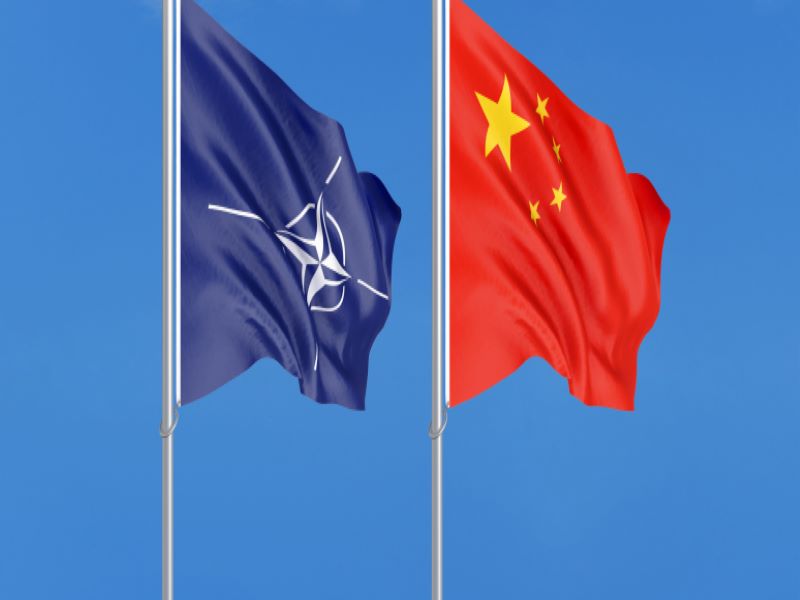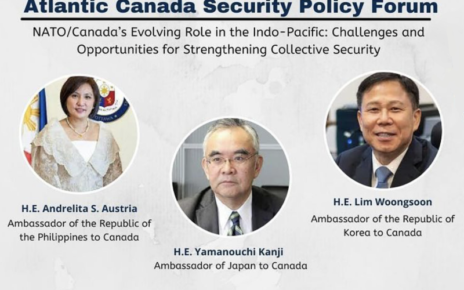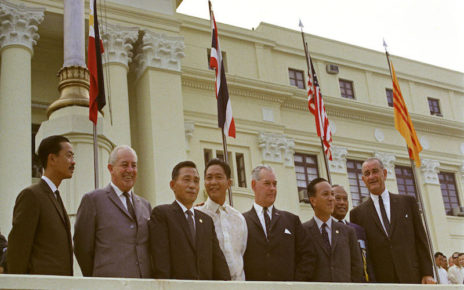This Special Report accompanies Canada, NATO, and the Indo Pacific, funded by the Department of National Defence MINDS Program.
Being the most successful military alliance in history, NATO has adapted its strategic outlook to contend with the geo-security threats of its day. From its inception, NATO has been primed to deter and defend its eastern flank against the Soviet Union during the Cold War. Following the collapse of the Soviet Union in 1991, and during America’s unipolar moment, the Alliance maneuvered its strategic outlook towards inclusion of a southern flank in the wake of the 9/11 terrorist attacks. In recent years, NATO’s northern flank has been given significant attention and resources due to Russia’s Arctic military projection and Chinese extra-regional interest.
For NATO, these geo-security peripheries are classified as the primary geopolitical zones of importance for Euro-Atlantic security and defence, seeing that 28 members inhabit close geographical borders with either one or two of these aforementioned flanks. However, there is another geopolitical flank that is missing in NATO’s strategic outlook—the Pacific coast of Canada and the United States (US).
At NATO’s London Summit in December 2019, the Alliance recognized that “China’s growing influence and international policies present both opportunities and challenges.” By contrast, its communiqué from the 2021 NATO Summit referred to China’s regional and global characteristic as a systemic challenge to the rules-based international order and to geo-security areas relevant to Alliance security.
Despite these strategic maneuvers, NATO is finding it difficult to reach a consensus on how the Alliance should engage with the Indo-Pacific and contend with China, reflecting the wide-range views and national interests that impede NATO in terms of crafting a reliable strategy. To resolve this strategic quagmire, NATO must classify its western flank as a vital geopolitical and geo-security periphery to showcase its importance on intra-alliance cohesion and unity, along with its use in offering the Alliance wider strategic tools to uncover the geo-security threats and challenges arising from China and the Indo-Pacific.
A Historical Retrospective
The concept of a western flank can be traced to the 1960s when New York Times foreign correspondent C.L. Sulzberger inquired if NATO’s European members would confront future Chinese military aggression against the US. Emphasizing that the western flank was solely focused within America’s geo-security periphery, Sulzberger concluded that NATO’s European members would not shift westward, instead choosing to defend and contain the Alliance’s eastern flank against the Soviet Union as initially designed. At the end of Sulzberger’s examination, he mentioned that NATO’s European members would be bound by Article V to help the US in defending its western flank if the Soviets attacked across the Bering Strait or by launching missiles from the Arctic.
NATO’s western flank was also hinted at by Dean Rusk, US Secretary of State from 1961 to 1969, on the eve of China becoming a nuclear power in 1964; “one day America may be on the firing line of the world’s newest nuclear power, ‘Red China.’” To showcase the seriousness of this possible geo-security threat, Rusk reminded his European NATO counterparts that North America was inside the defence mandate of the Alliance and would expect NATO allies to hurry to their aid in the event of an attack by China. Rusk also asserted the legitimacy of NATO’s western flank as Canada and the US had extensive geographical coastlines along the Pacific.
During the 2021 NATO Summit, French President Emmanuel Macron charged that “NATO is an organization that concerns the North Atlantic, China has little to do with the North Atlantic.” Interestingly, President Macron was among the first to proclaim such a staunch position on the geo-security challenges posed by China as France once argued for its southern flank to be protected and made a geo-security periphery of NATO. Due to years of fighting in Algeria, a former French colony, France proposed to NATO during the Cold War that a southern flank would shore up the geo-security perimeters against new hostiles and rivals. Interestingly today, NATO’s southern flank has become the second most important geo-security flank due to North Africa and the Middle East being fragile to terrorist organizations and mass migration.
The Western Flank’s Geo-Security Gravity
When assessing the geo-security gravity from China’s great power rise, regionally and globally, the main concerns do not negate NATO’s historical dilemma arising from its aforementioned western flank. For instance, the nuclear threat that China constitutes remains unchecked in the strategic thinking of NATO leaders from the 1960s to now. After observing China’s nuclear and militaristic posture towards Taiwan, the South China Sea, and the US, NATO Secretary-General Jens Stoltenberg rightfully asserted that NATO’s interests in China were natural, given its conventional nuclear capabilities and its progress to invest heavily in new intercontinental and hypersonic missile systems that can reach all NATO countries.
With China undergoing a vast nuclear modernization, President Xi Jinping seeks to further Chinese nuclear capabilities to establish military superiority over the US in specific geopolitical peripheries to achieve its military and political objectives of regional hegemony and status as a global great power. In lieu of these developments, any discussion around NATO’s western flank should emphasize the role of the Alliance in upholding Article V in a non-European geopolitical theatre.
The Gravity of China’s Unconventional Power
The previous Trump administration was momentous in cautioning the Alliance about China’s digital and economic power in a similar fashion to how former US Secretary of State Dean Rusk alerted NATO to the potential geo-security challenges of a nuclear China in 1964. After hearing these announcements, NATO Secretary-General Jens Stoltenberg exclaimed that ‘China is coming closer to us. We see them in Africa, in the Arctic, investing in infrastructure in Europe and also in cyberspace.’
Almost overnight, the Alliance was fractured over America’s insistence that Europeans “over-relied” on Chinese economic investments and 5G technologies. However, the US vigilance was validated when China began to use its economic investments to attain its core interest— territorial disputes over Taiwan, Tibet, Xinjiang, the South China Sea, and the exclusion of State-Owned-Enterprises, like Huawei, from European markets.
China also uses economic coercion against NATO’s European members through trade sanctions, investment restrictions, tourism bans, widespread boycotts, and restrictions on official travel when it does not get its way on diplomatic matters. Just recently, China recalled its ambassador from Lithuania, limited trade, and suspended rail services between the two countries over Lithuania authorizing Taiwan to open a representative office in Vilnius in addition to plans to open a reciprocal office in Taipei. China has also exerted unconventional hard power through state-issued threats and arbitrary detention of NATO allies’ state officials, like the two Michaels from Canada.
In cyberspace the PLA is maximizing its ability to conduct multiple cyber operations, ranging from cyber theft, cyber reconnaissance, cyberwarfare, and cyberattacks on information and military systems and civilian electric grids. In response to these discoveries, NATO condemned China’s ongoing ‘disinformation campaign,’ ‘widespread intellectual property theft’ and ‘cyberattacks’ on NATO members.
The Gravity of China’s Conventional Power
In terms of conventional power, China is due to have the second-largest military globally by 2050, a distinct great power feature that will enable it to project its security and defence interests outside its regional jurisdiction. China has also made it clear that it yearns for the People’s Liberation Army Navy (PLAN) to evolve its green-water maritime capabilities into an efficient blue-water force. With a powerful blue-water navy, it can be anticipated that China will seek new military engagements in extra-regional jurisdictions to promote, protect and procure its geo-economic, and by default, geo-security interests.
Given China’s experience in conducting naval operations in the transatlantic region, NATO cannot flout future PLAN endeavours to interject on Euro-Atlantic maritime affairs. China could also use its blue-water navy to showcase its influence on vital European ports it has built as part of its global economic strategy, such as the 16+1 bloc and the Belt and Road Initiative. With greater Chinese extra-regional engagements, NATO’s European members will observe Chinese merchant vessels and PLAN naval ships at the Greek port of Piraeus, the Algerian port of Tanger Med, and other North African ports, resulting in NATO military forces to operate within close proximity of the PLAN in their backyard.
China’s declaration of ‘being a near-Arctic’ state at the Arctic Council in 2018 will also have eminent geo-security complications for NATO’s western flank. With its enormous investments in the Scandinavian countries, through its Polar Silk Road, China will increase its extra-regional footprint over the region. As a result, NATO could witness China establish a “Sino Atlantic Strategy” that will permanently coordinate and station PLAN and Chinese Coast Guard vessels in the Arctic and along its western flank.
To navigate to and from the Arctic, China will use the Pacific route thereby resulting in considerable congestion of sea lines of communication and intercrossing American and Canadian economic exclusive zones. Moreover, China would undoubtedly provide “white hull diplomacy”—ranging from rapid Coast Guard responses to inter-jurisdictional hassles like shipwrecks, ship collisions, equipment breakdowns, and search and rescue—to maritime geo-security issues.
Keeping America in, Europe Assured & NATO Capable
As the Alliance revamps its strategic concept to reflect the changing nature of a complex multipolar rules-based order and heighten power politics and strategic competition, NATO must recognize the legitimacy of its western flank’s historical and contemporary geo-security challenges. Moreover, to ensure the significance of the alliance to American, Canadian, and European leaders, NATO must develop a formula to keep America in, Europe assured and NATO capable.
To keep America in, NATO’s European members must acknowledge the western flank of the US and Canada as a paramount geo-security periphery. Aside from recognizing the challenges China poses to the norms and values NATO is founded on, legitimizing the geo-security concerns arriving from its western flank can better organize and arrange the Alliance’s political, military, and diplomatic consensus of the threat perception emanating from its westernmost periphery.
A recognition from NATO’s European members on this subject will forecast to America that the Alliance observes its western flank, and the geo-security challenges arrive from it, as a direct and existing dynamic that has vital importance for NATO’s collective security and defence mandate. It can be anticipated that America would feel more confident in its security commitments to Europe as it would sense a certain reciprocal level of support by its allies for its geo-security concerns that are close to home.
In turn, Europe would be assured, that America would not abandon its geo-security commitments to the eastern flank. With both transatlantic centers balancing their geo-security peripheries, thereby restoring a sense of collective defence and security, NATO would be able to generate more cohesion in the Alliance’s strategic outlook on China and the consequences to the Alliance’s western flank. With more intra-alliance unity, NATO would be more capable of strategizing and responding to the geo-security challenges that will materialize out of a shifting multipolar rule-based order and the reality of bordering two antagonistic powers to its western and eastern flanks.
Conclusion
By taking NATO’s western flank more seriously, the Alliance can manage its intra-alliance cohesion and unity towards better fulfilling its principal mission. Not only will NATO’s western flank strategy unveil to China its seriousness in defending its members from conventional and unconventional geo-security threats, but it will also prove that the Alliance is relevant in dealing with the geo-security dilemmas and problems of the current international system—re-emphasizing its strategic posture to all or any contenders that seek dismantle the most successful alliance in history. Lastly, by recognizing NATO’s western flank, the Alliance would successfully find a functional formula that can “keep America in, Europe assured and NATO capable.”
Photo: The flags of NATO & China (2021). By IFRI. Public Domain.
Disclaimer: Any views or opinions expressed in articles are solely those of the authors and do not necessarily represent the views of the NATO Association of Canada.




